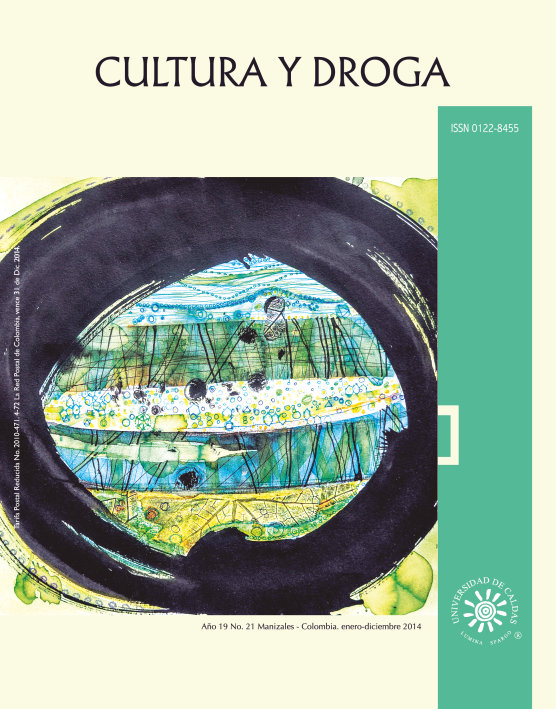##plugins.gregg.article.details.published##: 2014-01-01
Como Citar
Yamamoto, M. (2014). -. Cultura Y Droga, 19(21), 57–86. Recuperado de https://revistasojs.ucaldas.edu.co/index.php/culturaydroga/article/view/4137
Fomatos de Citação
Autores
Resumo
-
Palavras-chave
Referências
Blake, W. (2009). Augurios de la inocencia. Recuperado de http://archivodepoetica.blogspot.jp/2009/07/augurios-de-la-inocencia-william-blake.html
Caillois, R. (1986). Los juegos y los hombres: la máscara y el vértigo. Ciudad de México, México: Fondo de Cultura Económica.
Castañeda, C. (1971). A Separate Reality. Harmondsworth, England: Penguin.
Furst, P. (1976). Hallucinogens and Culture. New York, USA: Praeger Publishers.
Geertz, C. (2006). La interpretación de las culturas. Barcelona, España: Gedisa.
Gehlen, A. (1970). Ningen-gaku no Tankyuu (Anthropologische Forschung). Tokyo, Japan: Kinokuniya.
Harner, M. (1972). The Jivaro: People of the Sacred Waterfalls. New York, USA: Doubleday, Natural History Press.
Harner, M. (1980). The Way of the Shaman. San Francisco, USA: Harper & Row.
Hirukawa, T. (2002). Higan no Toki. Tokyo, Japan: Shunjusha.
Huxley, A. (2010). Las puertas de la percepción. Cielo e infierno. Ciudad de México, México: Editores Mexicanos Unidos.
Ikemi, Y. (1985). Estados alterados de conciencia. Diversos estados de nervios, psique, fisiología y conciencia. Barcelona, España: Gedisa.
Ishikawa, M. (1967) México ni okeru ‘seinaru kinoko-girei’ no taiken. Minzokugaku Kenkyu. The Japanese Journal of Ethnology, 31 (4), 299-300.
Izutsu, T. (1980). Islam Tetsugaku no Genzou. Tokyo, Japan: Iwanami.
Izutsu, T. (1983). Ishiki to Honshitsu. Tokyo, Japan: Iwanami.
Kenji, M. (s.f.). Aomori Banka. Recuperado de http://why.kenji.ne.jp/haruto/152aomor.html
Ludwig, A. (1972). Altered States of Consciousness. New York, USA: Doubleday.
Maki, Y. (1977). Kiryu no Naru Oto. Tokyo, Japan: Chikuma.
Michaux, H. (1957). L’infini turbulent. Paris, France: Mercure de France.
Miyamoto, T. (1977). Seishin Bunretsubyo no Sekai. Tokyo, Japan: Kinokuniya.
Miyanishi, T. (1985). Maya-jin no Seishin-sekai heno Tabi. Osaka, Japan: Osaka Shoseki.
Nakamaki, H. (1992). Hajime ni ekitai ariki: Brasil ni okeru genkaku shukyo no soseiki. Tokyo, Japan: Heibonsha.
Noll, R. (1983). Shamanism and Schizophrenia: A State Specific Approach to the Schizophrenia Metaphor of Shamanic States. American Ethnologist, 10 (3), 443-459.
Reichel-Dolmatoff, G. (1978). Beyond the Milky Way: Hallucinatory Imagery of the Tukano Indians. Los Angeles, USA: UCLA, Latin American Center Publications.
Sartre, J.-P. (1967). La náusea. Buenos Aires, Argentina: Losada.
Shanon, B. (2003). The Antipodes of the Mind: Charting the Phenomenology of the Ayahuasca Experience. New York, USA: Oxford University Press.
Tanikawa, S. (1993). Tabi 4 Alicante. Korega Watashi no Yasashisa desu. Tokyo, Japan: Shueisha.
Yamamoto, M. (2002). Genkakuzai to chiryou. Psychedelics to Bunka. Tokyo, Japan: Shunjusha.
Caillois, R. (1986). Los juegos y los hombres: la máscara y el vértigo. Ciudad de México, México: Fondo de Cultura Económica.
Castañeda, C. (1971). A Separate Reality. Harmondsworth, England: Penguin.
Furst, P. (1976). Hallucinogens and Culture. New York, USA: Praeger Publishers.
Geertz, C. (2006). La interpretación de las culturas. Barcelona, España: Gedisa.
Gehlen, A. (1970). Ningen-gaku no Tankyuu (Anthropologische Forschung). Tokyo, Japan: Kinokuniya.
Harner, M. (1972). The Jivaro: People of the Sacred Waterfalls. New York, USA: Doubleday, Natural History Press.
Harner, M. (1980). The Way of the Shaman. San Francisco, USA: Harper & Row.
Hirukawa, T. (2002). Higan no Toki. Tokyo, Japan: Shunjusha.
Huxley, A. (2010). Las puertas de la percepción. Cielo e infierno. Ciudad de México, México: Editores Mexicanos Unidos.
Ikemi, Y. (1985). Estados alterados de conciencia. Diversos estados de nervios, psique, fisiología y conciencia. Barcelona, España: Gedisa.
Ishikawa, M. (1967) México ni okeru ‘seinaru kinoko-girei’ no taiken. Minzokugaku Kenkyu. The Japanese Journal of Ethnology, 31 (4), 299-300.
Izutsu, T. (1980). Islam Tetsugaku no Genzou. Tokyo, Japan: Iwanami.
Izutsu, T. (1983). Ishiki to Honshitsu. Tokyo, Japan: Iwanami.
Kenji, M. (s.f.). Aomori Banka. Recuperado de http://why.kenji.ne.jp/haruto/152aomor.html
Ludwig, A. (1972). Altered States of Consciousness. New York, USA: Doubleday.
Maki, Y. (1977). Kiryu no Naru Oto. Tokyo, Japan: Chikuma.
Michaux, H. (1957). L’infini turbulent. Paris, France: Mercure de France.
Miyamoto, T. (1977). Seishin Bunretsubyo no Sekai. Tokyo, Japan: Kinokuniya.
Miyanishi, T. (1985). Maya-jin no Seishin-sekai heno Tabi. Osaka, Japan: Osaka Shoseki.
Nakamaki, H. (1992). Hajime ni ekitai ariki: Brasil ni okeru genkaku shukyo no soseiki. Tokyo, Japan: Heibonsha.
Noll, R. (1983). Shamanism and Schizophrenia: A State Specific Approach to the Schizophrenia Metaphor of Shamanic States. American Ethnologist, 10 (3), 443-459.
Reichel-Dolmatoff, G. (1978). Beyond the Milky Way: Hallucinatory Imagery of the Tukano Indians. Los Angeles, USA: UCLA, Latin American Center Publications.
Sartre, J.-P. (1967). La náusea. Buenos Aires, Argentina: Losada.
Shanon, B. (2003). The Antipodes of the Mind: Charting the Phenomenology of the Ayahuasca Experience. New York, USA: Oxford University Press.
Tanikawa, S. (1993). Tabi 4 Alicante. Korega Watashi no Yasashisa desu. Tokyo, Japan: Shueisha.
Yamamoto, M. (2002). Genkakuzai to chiryou. Psychedelics to Bunka. Tokyo, Japan: Shunjusha.
Downloads
Não há dados estatísticos.

 PDF (Español)
PDF (Español)
 FLIP
FLIP

















